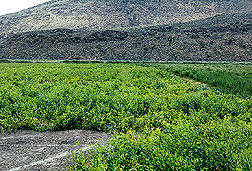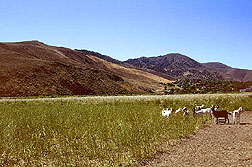Toppling Tall Whitetop
|
|
Could hungry goats serve as natural lawnmowers for tall whitetop, a weed crowding out native plants in western states?
In a preliminary summer grazing test with 13 young goats, the animals ate the white-flowered pest with no ill effects. That's important, because scientists aren't completely certain whether the plant is poisonous to animals.
A combination of tactics--grazing, herbicides, mowing, and seeding with aggressive annual plants--might be needed to quell the weed, says range scientist James A. Young. He is with the Agricultural Research Service in Reno, Nevada.
Right now, ranchers and other land managers have no fast, easy way to keep tall whitetop at bay. Cattle and sheep, Young says, will graze it when it grows amid other plants, but they won't tackle pure, dense stands of this weed. The plant is also known as perennial pepperweed.
Young and colleagues fenced the goats in an infested meadow on a floodplain of the Truckee River in Nevada. The animals grazed thick stands of tall whitetop, along with regrowth from those stands and from mowed stands. They preferred the young, tender, more digestible regrowth, eating about 75 percent of it--compared to about half of the vegetation in older stands. On older plants, they ignored the semi-woody stems and nibbled only leaves and soft tips.
Young leads the Ecology of Temperate Desert Rangelands Research Unit at Reno. He and technician Charles D. Clements, also of the Reno team, conducted the test along with Lynn F. James, director of ARS' Poisonous Plant Research Laboratory in Logan, Utah. The Logan lab provided the goats.
|
|
Native to southern Europe and southwestern Asia, tall whitetop has cropped up in nearly every western state. It's also well-established in New England. It thrives along streams, rivers, ditches, irrigation canals, and salty marshes, and it spreads easily to adjacent meadows. Tall whitetop typically grows 1 to 3 feet tall, but can reach 8 feet in wet sites.
Tall whitetop is an unlikely candidate for control by beneficial weed-eating insects. That's because, as a member of the mustard family, it is related to several crops, including broccoli, cabbage, and horseradish.
"Our lab," says Young, " has smelled like horseradish ever since we started studying tall whitetop in 1990. The odor is overpowering."
This year, researchers in Logan plan toxicity tests using sheep. Reno-based scientists will launch a new goat experiment with perhaps 30 animals.
In late summer, after the grazing portion of the study, the Reno scientists intend to test candidate herbicides
Unfortunately, the chemicals don't travel to the weed's deep roots or to its rhizomes--rootlike extensions dotted with sprouts. So Young is pursuing greenhouse and outdoor tests to see what tactics might forestall roots and rhizomes.
Another alternative has emerged from greenhouse studies at Reno. These tests suggest dense stands of the weed may so greatly deplete soil nutrients that plant species with root systems better suited for searching out nutrients might outcompete it. Soil scientist Robert R. Blank conducted the tests, pitting whitetop against cheatgrass, an aggressive annual.
"If the same effect holds in outdoor tests," he says, "we might be able to use a similarly aggressive, densely rooted native grass."--By Marcia Wood, Agricultural Research Service Information Staff.
James A. Young, Robert R. Blank, and Charles D. Clements are in the USDA-ARS Ecology of Temperate Desert Rangelands Research Unit, 920 Valley Rd., Reno, NV 89512; phone (702) 784-6057, fax (702) 784-1712.
Lynn F. James is at the USDA-ARS Poisonous Plant Research Laboratory, 1150 E. 14 N., Logan, UT 84341; phone (435) 752-2941, fax (435) 753-5681.
"Toppling Tall Whitetop" was published in the July 1998 issue of Agricultural Research magazine. Click here to see this issue's table of contents.








